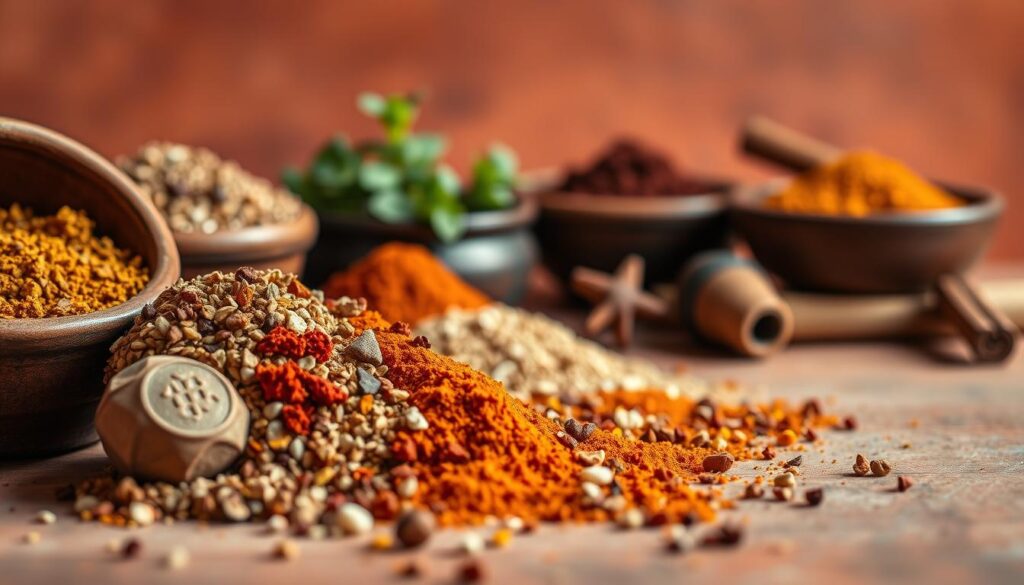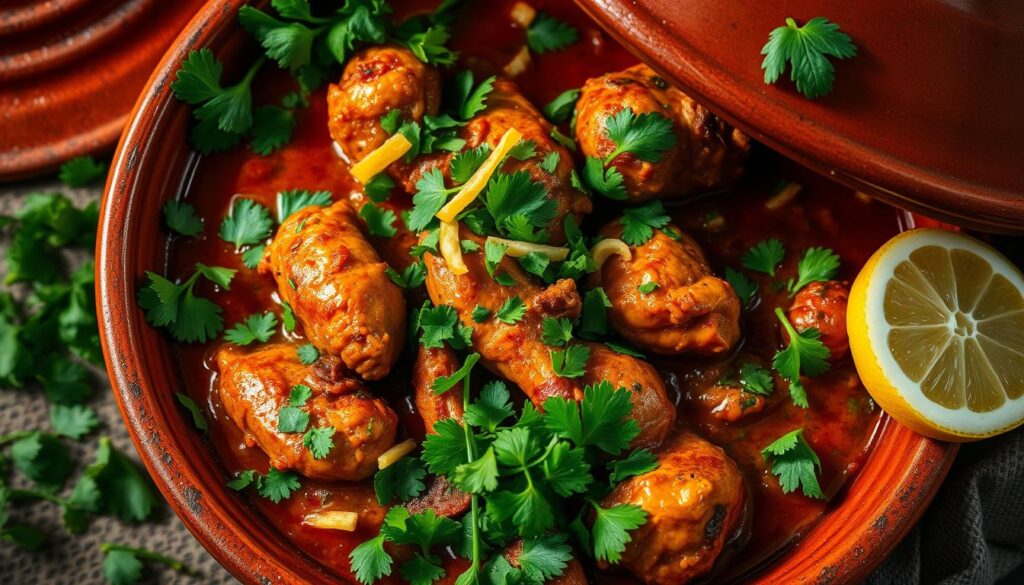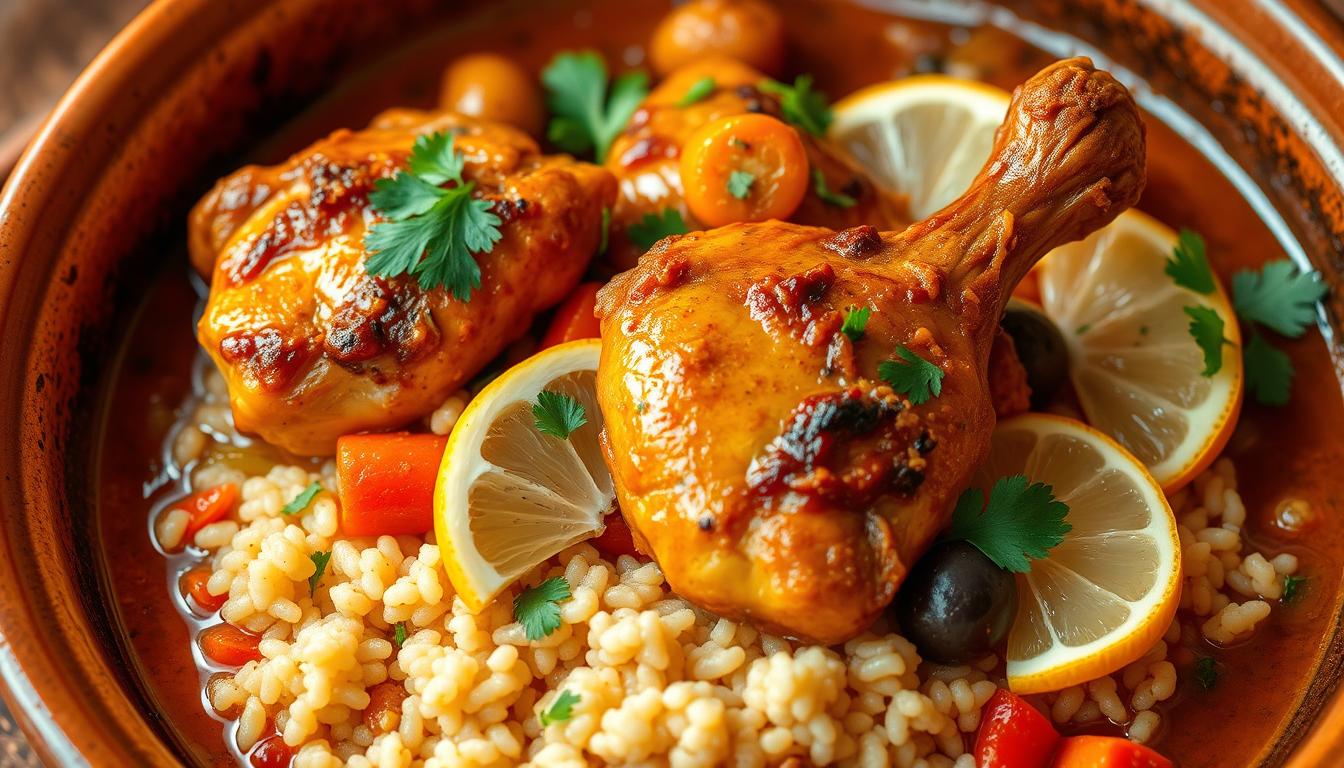Are you ready to embark on a culinary journey to North Africa? Have you ever wondered what makes a traditional chicken tagine recipe so special?
The answer lies in the rich blend of aromatic spices, tender chicken, and dried fruits that come together to create a hearty and flavorful meal. Named after the earthenware pot in which it’s cooked, this dish is a staple of Moroccan cuisine.
This authentic recipe is not just a meal; it’s an experience. With its perfect balance of flavors and textures, it’s sure to become a favorite in your kitchen.
Key Takeaways
- Learn the origins of the traditional North African dish
- Discover the key ingredients for an authentic flavor
- Understand the cooking techniques involved
- Explore the cultural significance of the earthenware pot
- Enjoy a hearty and flavorful meal with family and friends
Introduction to Moroccan Chicken Tagine
In the heart of Moroccan cuisine lies the Tagine, a dish as rich in history as it is in flavor. This traditional North African stew is not just a meal; it’s an experience that combines tender chicken, aromatic spices, and dried fruits in a clay pot with a conical lid.
What is a Tagine?
A Tagine is both a dish and a cooking vessel. The clay pot with a conical lid is designed to allow the steam to rise and condense, then drop back into the dish, creating a moist and flavorful stew. The slow-cooking process ensures that the chicken is tender and the flavors are rich and complex.
The Origins of Tagine Cooking
The origins of Tagine cooking date back to the Berber tribes of North Africa, where it was cooked over an open flame. This method of cooking has been passed down through generations, with each region adding its unique twist to the recipe. As one culinary expert notes,
“Tagine is a reflection of the rich cultural heritage of Morocco, where every ingredient tells a story.”
Why You’ll Love This Recipe
You’ll love this Moroccan Chicken Tagine recipe for its authentic Moroccan flavors and the ease of preparation. The combination of spices, chicken, and dried fruits creates a dish that is both comforting and exotic. It’s a perfect recipe for anyone looking to explore the depths of North African cuisine.
The best part? It’s incredibly versatile. You can serve it with couscous, Moroccan bread, or even on its own. The leftovers are just as delicious, making it a great option for meal prep.
Key Ingredients for Moroccan Chicken Tagine
Moroccan Chicken Tagine, a dish renowned for its rich flavors, relies heavily on the quality of its ingredients. The success of this traditional North African stew depends on the careful selection of chicken, spices, and other components.
Chicken Choices: Thighs vs. Breasts
When it comes to choosing the right chicken for your Tagine, you have two primary options: thighs or breasts. Chicken thighs are generally preferred for Tagine because of their higher fat content, which keeps the meat moist and flavorful during the long cooking process. On the other hand, chicken breasts can be used for a leaner version, but they require more careful cooking to prevent drying out.
Spices That Make the Difference
The unique flavor profile of Moroccan Chicken Tagine is largely attributed to its spice blend. Key spices include:
- Cumin
- Coriander
- Paprika
- Cinnamon
- Turmeric
These spices come together to create the signature Moroccan spice blend that gives Tagine its distinctive taste.
Fresh vs. Dried Ingredients
The debate between using fresh versus dried ingredients is crucial in Tagine preparation. While fresh ingredients provide vibrant flavors, dried ingredients like apricots and prunes add a depth of flavor and texture that is characteristic of the dish.

Preparing Your Chicken for Tagine
Preparing your chicken and vegetables is a crucial step in making a flavorful Moroccan Chicken Tagine. This step ensures that your dish is not only delicious but also visually appealing.
Marinating Chicken for Maximum Flavor
Marinating the chicken is a vital step that infuses it with the rich flavors of Moroccan cuisine. To marinate, mix chicken pieces with a blend of spices, including cumin, coriander, and paprika, along with some olive oil, garlic, and lemon juice. Let it sit for at least a few hours or overnight for the best results.
The acidity in the lemon juice helps to tenderize the chicken, while the spices penetrate deep into the meat, enhancing its flavor. If you’re using preserved lemons, chop them finely and add them to the marinade for an extra burst of tangy flavor.
Prepping Vegetables: Best Choices
Selecting the right vegetables is crucial for a well-rounded Tagine. Common choices include onions, carrots, and potatoes, which add texture and flavor to the dish. You can also add other vegetables like zucchini or bell peppers to suit your taste.
Chop the vegetables into uniform pieces to ensure they cook evenly. For a traditional touch, include some chicken tagine with preserved lemons by adding chopped preserved lemons towards the end of cooking.
Tips for Even Cooking
To achieve even cooking, make sure that both the chicken and vegetables are cut into similar-sized pieces. This helps them cook at the same rate, preventing some parts from being undercooked or overcooked.
Another tip is to layer the ingredients properly in the Tagine pot. Typically, you’ll start with a layer of onions and spices at the bottom, followed by the chicken, and then the vegetables. This layering helps distribute the heat evenly and ensures that all the flavors meld together.
Cooking Techniques for the Perfect Tagine
Mastering the art of cooking a traditional Moroccan tagine is a journey that combines patience, technique, and a deep understanding of the rich flavors involved. The right cooking technique is crucial to achieving the tender, fall-apart texture and the rich, complex flavors that characterize a well-cooked tagine.
Slow Cooking vs. Pressure Cooking
When it comes to cooking a tagine, two popular methods stand out: slow cooking and pressure cooking. Slow cooking is the traditional method, where the tagine is cooked over low heat for an extended period, allowing the flavors to meld together and the meat to become tender. This method is ideal for those who have the time to let the tagine cook slowly, developing a depth of flavor that is hard to match.
On the other hand, pressure cooking is a modern alternative that significantly reduces the cooking time. It’s perfect for those who are short on time but still want to enjoy a delicious and authentic tagine. The pressure cooker locks in the flavors and tenderizes the meat quickly, making it a great option for busy cooks.

Using a Traditional Tagine Pot
A traditional tagine pot is a clay or ceramic vessel with a distinctive conical lid. It’s designed to allow the steam to rise, condense, and then drop back into the dish, creating a moist and flavorful stew. Using a traditional tagine pot is not just about cooking; it’s an experience that connects you to the rich culinary heritage of Morocco.
The clay pot distributes heat evenly, ensuring that the tagine cooks consistently. It’s essential to season the pot before use and to handle it with care to prevent cracking.
Alternative Cooking Methods
While a traditional tagine pot is ideal, it’s not the only way to cook a tagine. Alternative cooking methods include using a Dutch oven, a slow cooker, or even an Instant Pot. Each of these methods has its advantages and can produce a delicious tagine.
| Cooking Method | Cooking Time | Flavor Profile |
|---|---|---|
| Slow Cooking | 2-3 hours | Rich, complex flavors |
| Pressure Cooking | 30-45 minutes | Deep, intense flavors |
| Dutch Oven | 1-2 hours | Well-balanced, rich flavors |
By understanding the different cooking techniques and methods available, you can choose the one that best suits your needs and preferences, ensuring that your tagine is always delicious and authentic.
Essential Spices in Moroccan Cuisine
Moroccan cuisine is renowned for its rich and diverse use of spices, which are fundamental to creating the authentic flavors of dishes like Chicken Tagine. The art of blending spices is a centuries-old tradition in Morocco, where each spice is carefully selected for its unique flavor and aroma.
Cumin, Coriander, and Paprika
Cumin, coriander, and paprika form the backbone of many Moroccan spice blends. Cumin adds a warm, earthy flavor, while coriander contributes a slightly sweet and citrusy note. Paprika, especially the sweet variety, enhances the dish with a smoky depth.
These spices are often used together to create a balanced flavor profile. For instance, cumin and coriander are commonly paired to add warmth and depth to the Tagine, while paprika is used to give it a rich, slightly smoky flavor.
| Spice | Flavor Profile | Usage in Tagine |
|---|---|---|
| Cumin | Warm, Earthy | Base flavor |
| Coriander | Sweet, Citrusy | Complements cumin |
| Paprika | Smoky, Sweet | Adds depth |
The Role of Saffron and Ras El Hanout
Saffron and Ras El Hanout are two of the most distinctive and expensive spices used in Moroccan cuisine. Saffron, known for its luxurious flavor and vibrant yellow color, is often used sparingly to add a subtle earthy and aromatic flavor to the Tagine.
“Ras El Hanout, which translates to ‘head of the shop,’ is a complex blend of spices that can include up to 30 different ingredients, including cardamom, cumin, cinnamon, and rose petals. It’s a signature spice mix that adds a unique and aromatic flavor to Moroccan dishes.”
Ras El Hanout is used to add a complex and aromatic flavor profile to the Tagine. The exact composition of Ras El Hanout can vary significantly depending on the region and the cook, making it a fascinating element of Moroccan culinary tradition.
Seasoning Throughout the Cooking Process
Seasoning is a critical aspect of cooking Moroccan Chicken Tagine. Spices are added at various stages of the cooking process to build layers of flavor. Initially, spices like cumin, coriander, and paprika are used to marinate the chicken, infusing it with flavor.
As the Tagine cooks, additional spices, including saffron and Ras El Hanout, are added to enhance and deepen the flavor. This gradual layering of spices ensures that the final dish is rich, complex, and aromatic.
Adding Flavor with Fruits and Nuts
In the rich tapestry of North African cuisine, the Moroccan Chicken Tagine stands out for its use of fruits and nuts. This traditional dish is a masterclass in balancing flavors and textures, with fruits and nuts playing a crucial role.
Fruits and nuts add a delightful contrast to the savory flavors of the Tagine. They are not just additions; they are integral to the authentic flavor profile of the dish.
The Sweetness of Dried Apricots and Raisins
Dried apricots and raisins are staples in Moroccan cooking, bringing a natural sweetness that complements the spices and chicken. Dried apricots contribute a chewy texture and a sweet, slightly tangy flavor, while raisins add bursts of sweetness throughout the dish.
The use of dried fruits in Tagine is a testament to the resourcefulness of Moroccan cuisine, utilizing ingredients that are available year-round.
Almonds and Their Crunchy Texture
Almonds are another key ingredient, providing a satisfying crunch that contrasts with the tender chicken and soft fruits. They can be used whole, sliced, or slivered, depending on the desired texture.
To incorporate almonds effectively, they can be toasted to enhance their flavor before being added to the dish. This simple step elevates the overall flavor profile of the Tagine.
Here’s a comparison of the ingredients discussed:
| Ingredient | Contribution to Tagine | Preparation Tip |
|---|---|---|
| Dried Apricots | Sweetness and Chewy Texture | Rehydrate by soaking in water or broth |
| Raisins | Bursts of Sweetness | Add directly to the Tagine |
| Almonds | Crunchy Texture | Toast before adding to enhance flavor |
Traditional Accompaniments for Tagine
The art of serving tagine lies not just in the dish itself, but in the accompaniments that complement its flavors. In Moroccan cuisine, traditional tagine is often paired with side dishes that enhance its rich and aromatic flavors.
Couscous: The Classic Side Dish
Couscous is a staple in North African cuisine and is traditionally served with tagine. The fluffy texture and mild flavor of couscous make it an ideal accompaniment to soak up the flavorful sauce of the tagine. To prepare couscous, simply steam it according to the package instructions, and serve it hot alongside your tagine.
- Use a steamer basket to cook couscous for the best results.
- Fluff the couscous with a fork before serving to separate the grains.
- Consider adding herbs or spices to the couscous for extra flavor.
Moroccan Bread: A Perfect Pairing
Another traditional accompaniment to tagine is Moroccan bread, also known as “khobz.” This crusty bread is perfect for dipping into the tagine’s sauce, adding a satisfying crunch to each bite. To make Moroccan bread, you’ll need flour, yeast, water, and salt. The dough is typically allowed to rise before being shaped into rounds and baked until golden brown.
Some key benefits of serving Moroccan bread with tagine include:
- The bread’s crusty texture provides a nice contrast to the tender tagine.
- The mild flavor of the bread won’t overpower the tagine’s complex flavors.
- Dipping the bread in the sauce adds an enjoyable interactive element to the meal.
Serving Suggestions and Garnishes
Garnishes and serving ideas can transform your Tagine into a feast for the eyes as well as the taste buds. The presentation of your Moroccan Chicken Tagine is not just about aesthetics; it enhances the overall dining experience.
Fresh Herbs for Presentation
Using fresh herbs is a simple way to add color and freshness to your Tagine. Parsley and cilantro are popular choices that complement the dish’s flavors. Simply chop the herbs finely and sprinkle them over the Tagine before serving.
The Importance of Lemon Zest
A sprinkle of lemon zest can add a burst of citrus flavor and aroma to your Tagine. It’s not just about the taste; the vibrant yellow of the zest also adds visual appeal. Grate the zest of a fresh lemon over your Tagine just before serving.

| Garnish | Effect |
|---|---|
| Fresh Parsley | Adds freshness and color |
| Lemon Zest | Provides citrus flavor and aroma |
| Cilantro | Complements the dish’s flavors |
By incorporating these simple garnishes and serving suggestions, you can elevate your Moroccan Chicken Tagine into a truly memorable meal that showcases authentic Moroccan flavors and is perfect for those looking for easy Tagine recipes.
Storing and Reheating Leftovers
Moroccan Chicken Tagine is a dish that improves with time, much like a fine wine, and proper storage is essential to enjoy it over several days. Knowing how to store and reheat your tagine correctly ensures that the flavors remain vibrant and the chicken stays tender.
Best Practices for Refrigeration
To keep your Moroccan Chicken Tagine fresh, it’s crucial to store it in an airtight container. This prevents the absorption of other flavors from the refrigerator and keeps the tagine moist.
Cool the tagine to room temperature before refrigerating it to prevent bacterial growth. When reheating, make sure it reaches an internal temperature of 165°F (74°C) to ensure food safety.
Creative Ways to Use Leftovers
Leftover chicken tagine with preserved lemons can be repurposed in various creative ways.
- Use it as a filling for sandwiches or wraps, adding a unique twist to your lunch.
- Mix it with cooked couscous and vegetables for a quick and easy salad.
- Serve it over rice or quinoa for a different meal.
Conclusion: Enjoying Moroccan Chicken Tagine at Home
Mastering the art of Moroccan Chicken Tagine is a culinary journey that brings the rich flavors of Moroccan cuisine to your table. With this recipe, you’re not just cooking a meal; you’re experiencing a tradition that has been passed down through generations.
Variations and Experimentation
Feel free to experiment with different ingredients to create your own unique variations of the chicken tagine recipe. Try adding different spices or substituting chicken with lamb for a new twist.
As you become more comfortable with the recipe, you can start to make adjustments based on your personal preferences, making each dish a reflection of your culinary creativity.
Exploring Flavors
Moroccan cuisine is known for its bold flavors and aromas. Don’t be afraid to explore and combine different flavors to enhance your tagine. The use of fresh herbs, citrus zest, and a variety of spices can elevate the dish to new heights.


